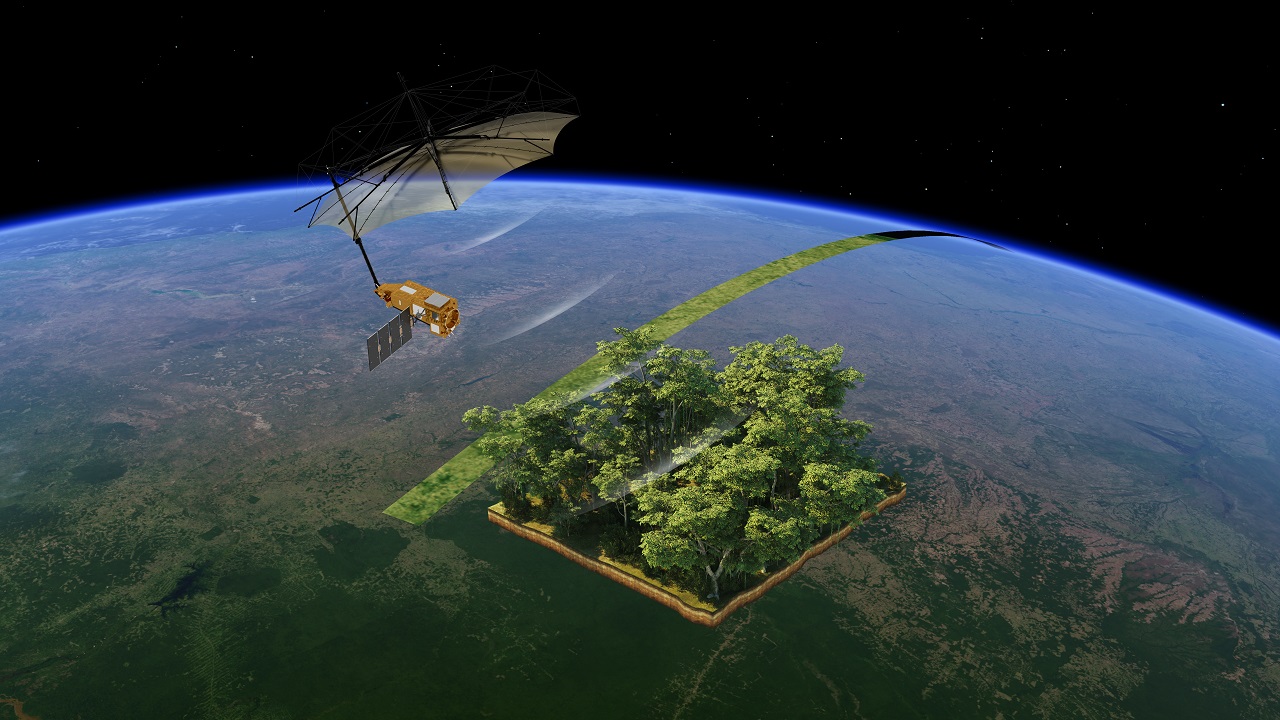Biomass Satellite Mission: A Landmark in Space-Based Forest Monitoring
Context
-
Forest ecosystems are a cornerstone of Earth’s environmental stability. They cover about 31% of the planet’s land surface and store more than 80% of terrestrial above-ground biomass carbon.
-
Forests play a key role in the global carbon cycle by absorbing atmospheric carbon dioxide (CO₂) and storing it in the form of biomass. However, due to activities such as deforestation, forest degradation, and climate change, forest health and carbon storage capacity are under threat.
-
Accurate, large-scale, and consistent global biomass data are crucial for:
-
Climate modelling
-
Emissions accounting
-
Sustainable forest management
-
Biodiversity conservation
-
-
Until now, satellite missions had limited capability in penetrating dense forest canopies to assess carbon storage. In this context, the European Space Agency (ESA) has developed the Biomass satellite mission, a pioneering effort to address this gap.
Key Features of the Biomass Satellite Mission
-
Launching Agency: European Space Agency (ESA)
-
Launch Vehicle: Vega-C rocket
-
Launch Site: Europe’s Spaceport in French Guiana
-
Orbit Type: Sun-Synchronous Orbit (SSO) at an altitude of 666 km
-
Ensures consistent lighting conditions and repeatable observations.
-
-
Primary Instrument:
-
World's first space-based satellite to use a P-band Synthetic Aperture Radar (SAR).
-
The P-band (435 MHz) radar wavelength is uniquely capable of penetrating dense vegetation layers.
-
Captures detailed data from tree trunks, branches, and stems — areas where 90% of forest biomass carbon is stored.
-
-
Mission Duration: 5 years
-
Data Output:
-
Generation of high-resolution 3D maps of forest biomass.
-
Annual biomass change estimates across global forests.
-
Scientific and Technological Significance
-
Breakthrough in Canopy Penetration:
-
Previous radar and optical satellites were hindered by cloud cover, especially in tropical regions.
-
The Biomass satellite’s P-band radar can operate under all weather conditions, day or night.
-
-
Global Biomass Assessment:
-
Will cover regions such as the Amazon, Congo Basin, Southeast Asia, and forests of the Indian subcontinent.
-
Offers a uniform, comparable global database on above-ground biomass (AGB).
-
-
Carbon Stock Monitoring:
-
Enables accurate estimation of carbon fluxes — emissions and removals due to land use.
-
A critical input for carbon trading, REDD+ accounting, and climate finance mechanisms.
-
Environmental and Climate Relevance
-
Forests absorb approximately 2.6 billion tonnes of CO₂ per year. Disturbances such as deforestation lead to massive carbon release.
-
ESA’s Biomass mission will:
-
Help identify carbon hotspots
-
Detect regions undergoing deforestation or regeneration
-
Track forest degradation that is often invisible to conventional satellites
-
-
Directly supports climate objectives under:
-
United Nations Framework Convention on Climate Change (UNFCCC)
-
Paris Agreement and its Global Stocktake process
-
SDG 13 (Climate Action) and SDG 15 (Life on Land)
-
Geopolitical and Policy Significance
-
Developing countries often lack infrastructure to conduct comprehensive forest assessments.
-
Biomass data will be made freely available, offering a significant boost to nations in:
-
South America
-
Central Africa
-
Southeast Asia
-
Indian subcontinent
-
-
Supports:
-
Transparency and accountability in global climate governance
-
Evidence-based policymaking for sustainable land use
-
Implementation of mechanisms like REDD+, carbon offsets, and ecosystem valuation
-
Relevance for India and the Global South
-
India’s forests, covering about 24.6% of its land area, are crucial for climate resilience, biodiversity, and livelihoods.
-
Biomass data will:
-
Complement national efforts under Green India Mission, CAMPA, and State of Forest Reports
-
Assist in identifying forest degradation zones
-
Help in monitoring carbon sequestration targets under India’s Updated NDCs (2022)
-
Conclusion
ESA’s Biomass satellite marks a watershed moment in the use of space technology for environmental sustainability. By providing globally consistent, high-quality data on forest biomass, it will enable more informed decisions in climate policy, forest management, and ecological conservation. The mission reaffirms how technological innovation can serve as a powerful tool for climate justice, especially for the developing world.




Comments (0)